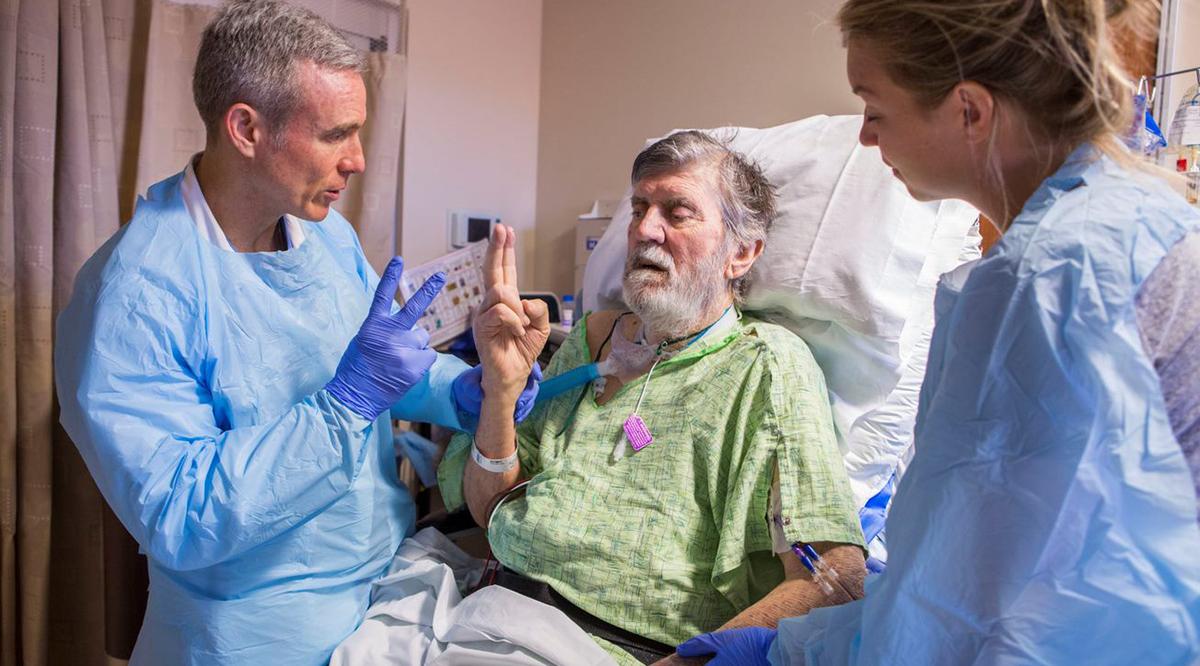Each year in the United States, more than 6 million people will land in an intensive care unit (ICU). When they get there, they will receive lifesaving measures such as intubation, which allows them to continue breathing. But they will also face some extreme risks.
Among the possible dangers from intensive care treatment is ICU delirium, a condition that can cause terrifying hallucinations and cognitive decline. Ultimately, many patients go home from the ICU with post-intensive care syndrome (PICS), a constellation of symptoms ranging from muscle weakness to posttraumatic stress disorder.
But all that is changing significantly, thanks in part to the work of Wes Ely, MD, MPH, who helped devise a groundbreaking approach to ICU care that’s now used in thousands of hospitals worldwide.
Ely, a professor of critical care medicine at Vanderbilt University Medical Center in Nashville, was motivated to pursue these innovations by the setbacks he saw for so many of his patients. One, a gifted 52-year-old mathematician, left the ICU after treatment for pneumonia with the brain of an 85-year-old suffering from dementia, Ely notes in his 2022 book, Every Deep-Drawn Breath: A Critical Care Doctor on Healing, Recovery, and Transforming Medicine in the ICU. Another, an active 53-year-old preacher, was so weak and confused that he lost the ability to live on his own following his ICU treatment for a lung infection.
For decades, Ely has conducted research on the new method’s efficacy and helped educate thousands on how to implement it. The approach includes using less sedation — which had been considered essential for keeping patients calm — as well as earlier weaning from ventilators. The end result: Patients achieve greater mobility, gain mental clarity, and renew the personal connections vital to healing.
The work required a major conceptual shift in critical care, from a focus purely on defeating death to one that emphasized post-ICU quality of life. As Ely writes, he discovered that “each patient is more than a mere beating heart or breathing lungs to be saved. The whole person — mind, body, and spirit — is at stake.”
In advance of his appearance at Learn Serve Lead 2022: The AAMC Annual Meeting on November 14 in Nashville, Ely spoke with AAMCNews about achieving dramatic improvements in ICU care, how the COVID-19 pandemic set back those advances, and how he’s managed to persevere despite numerous obstacles in his path.

You had some painful moments when you realized you were causing patients harm. Can you share one such story?
Teresa Martin was one of my first patients. The 28-year-old came to the Wake Forest Medical Center in Winston-Salem, North Carolina, after a suicide attempt that she later regretted. Teresa had lost consciousness, and several organs were in different stages of failing. We put her on a ventilator, immobilized her, and heavily sedated her. After several harrowing weeks, we were thrilled when she could leave the ICU.
A couple of months later, she came back to see me in the clinic. I thought it would be a high-five moment, but she came back in a wheelchair. She looked like an old woman. She couldn't go to the bathroom by herself. She couldn’t think clearly.
I just stared in the mirror and thought, ‘What did I do to her?’ I was a danger in her life. That really started the process of me kind of carrying around shame and guilt for many years, and then trying to unpack it.
What is ICU delirium, and why is it dangerous?
ICU delirium is the outward manifestation of ongoing brain injury. The person can’t think clearly, and they can’t pay attention.
ICU delirium can be caused by blood clots that prevent brain cells from getting the necessary oxygen. But it also can be caused by such ICU factors as sedating medications, strong painkillers, isolation, and unfamiliar surroundings.
Every additional day of delirium is a predictor of a 10% increased risk of death and a 35% increased risk of brain dysfunction. If you do the math, with three days, you’re one-third more likely to die and you’re practically assured to have long-term brain problems.
ICU stays can cause other life-altering harms. What are some of those, and how do they happen?
People come into the ICU with one problem, but then they acquire a whole new constellation of problems — PICS — that includes brain, muscle, and nerve problems. PICS causes tremendous disability.
When somebody comes into the ICU, the old way of caring for people was to tie them down and immobilize them. We thought we were helping them because it prevented them from pulling out their lines and tubes — but we grossly overdid it.
For example, disuse of muscles causes atrophy — and when you’re not healthy, the atrophy occurs way faster. People can lose 10% to 25% of their muscle mass in just four or five days. It’s shocking.
People may also leave with PTSD and other mental health issues. Part of it has to do with hallucinations. One patient believed he was in a game show every night, with people in front of him with bags on their heads and he had to shoot one of them. And every night when they took the bag off the person's head, it was always his daughter.
Part of what we have to do is help [ICU survivors] make sense out of their experience. And we need to say, ‘We won’t abandon you. We’ll accompany you down this road.’
You helped revolutionize ICU treatment. One dramatic step was to move away from heavily sedating patients. How did that help?
Less sedation is better for several reasons. One is that when you sedate somebody, they enter a deep coma. Their brain cells go into kind of a state of suspended animation that injures or kills the cells.
Also, although you look like you’re asleep in a coma, the sedation actually prevents healthy sleep. You go into a prolonged state of sleep deprivation, which is very dangerous for the body.
Sedation also fakes us out by making patients look sicker. If I wake patients up and let them be with their families, it’s amazing how much better they look, which affects other medical decisions staff make.
You suggested a number of other bold moves as well. Can you give some examples?
We created a safety bundle of six steps, with the abbreviation ABCDEF.
The bundle says to manage the pain without overmedicating — that’s A for Analgesia. Get rid of the ventilator and the sedation as soon as possible — that’s B for Both, a daily attempt to remove the sedatives and the breathing machine. There’s C for choice of analgesia and sedation. D is for treating delirium correctly, which includes environmental steps like using light to match day/night cycles. E is for early mobility. We wake you up and get you walking, sometimes with your respirator trailing behind you. And there’s F, having the family present and engaged.
We’ve studied this in over 30,000 people, and the higher the compliance with the bundle steps, the better the survival rates, the shorter the stays, the lower the cost, and the more likely you are to go back to your home instead of to a rehab facility.
We’ve translated this bundle into 40 languages, and it’s now used all over the world.
How hard was it to try to change ICU culture?
Oh, my gosh, it was terrible. We would come into an ICU and get people to use the new approach. But then the staff would change, and we’d come back a month later and they’d be right back to where they were before. It was maddening.
I knew that the only way to make this change would be with thorough research. Doctors and nurses are scientists. So, we had to study this in very intense detail and publish the results in the highest journals, which we did.
Along the way, a lot of people yelled at us, saying that we were being unethical because they thought waking people up would be physically and emotionally unsettling to them. A lot of people called me into their office and said, ‘What are you doing? This is going to be a career ender.’
How did the COVID-19 pandemic set back advances in ICU care?
Before COVID-19, around 90% of ICUs in the United States used our bundle. Not all of them complied with 100% of it, but they incorporated its major components. In one study of ICUs in 40 countries, staff were about 70% to 80% compliant with it, which is very high for clinical protocols. Then we measured it during COVID both in the U.S. and abroad, and we found they had dropped down to 10% to 20% compliance.
Isolating patients, restricting visitors, longer sedation, and more immobilization came back. Early in the pandemic, those were for legitimate reasons, including that we didn’t understand the virus well yet, we needed to manage a huge influx of patients, and we needed to protect people. But as soon as the vaccines were available and we had enough PPE [personal protective equipment], they didn’t make sense.
Unfortunately, hospitals sometimes just kept those policies in place, and there was a tremendous amount of undue suffering. We’ve got a long way to go to rebuild now.
What has helped you keep going despite major obstacles?
Patients are the drivers for me — their bravery, the gift of their stories. I’m on a mission for them. I’m donating all the net proceeds from Every Deep-Drawn Breath to an endowment at Vanderbilt that will leverage the talents of social workers to help ICU survivors all over the country and world pick up the pieces of their lives.
What I tried to bring out in the book is that you can’t take care of people with science alone. You’ve also got to pay attention to their minds and their spirits.
Most of what I have learned over the past 25 years is about bringing humanism to the bedside in all that we do — bringing care that is full of compassion and empathy. I’m still growing in this, and I have a long way to go. We must teach these traits to medical and nursing students as part of their curriculum.
I took the title Every Deep-Drawn Breath from Steinbeck’s East of Eden. In that book, Steinbeck says there is something so gorgeous and unique about the human condition, if we respect the dignity of who people are.
I found that when people are sedated, immobilized, and depersonalized in the ICU, it masks their human dignity. It masks who they are as people.
This conversation has been edited for brevity and clarity. Dr. Ely can be found on Twitter and TikTok at @WesElyMD.

